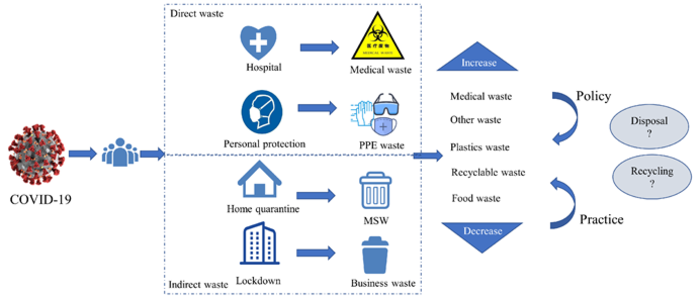The outbreak of COVID-19 has changed our life style, and even the environment around us, such as the reduction of carbon dioxide and nitrogen dioxide emissions and the alleviation of water pollution. A more obvious change is that the production of waste related to pandemic prevention has increased significantly. For example, the main component of disposable masks we used every day is plastic fiber. It is estimated that hundreds of billions of masks are used every month around the world. As the largest producer of masks, China’s daily output in March 2020 has exceeded 100 million. Before the pandemic, the world produced more than 300 million tons of plastic every year, most of which eventually entered into nature and decomposed into small plastic particles.
Since masks are not recyclable like plastic bottles, they are usually treated as solid waste. With the rapid increase in the number of newly diagnosed cases, hospitals, healthcare facilities and individuals have produced a variety of COVID-19 related wastes, including infected masks, gloves and other protective equipment, which not only could pollute the environment, but also have the risk of spreading diseases.
Researchers from Macao University of Science and Technology and Tsinghua University systematically studied the potential impact of COVID-19 pandemic on the generation and treatment of medical waste, personal protective equipment waste and municipal solid waste, and the findings were published in Frontiers of Environmental Science & Engineering.
The results show that, firstly, the pandemic has increased the generation of medical waste by 18% to 425%. It is estimated that the daily output of COVID-19 related medical waste in the world has increased from 200 tons per day in February to more than 29,000 tons per day in September during 2020. Secondly, in the long term, the demand for personal protective equipment will continue to grow. Moreover, the lockdown, isolation, quarantine and other measures have greatly reduced the volume of commercial waste in cities, especially in tourist cities, some of which have been transformed into domestic waste.
The spread of COVID-19 has also changed residents’ consumption behaviors. People are more willing to use online shopping and food delivery services during the pandemic than before. As a result, it may lead to an increase in the amount of disposable plastic waste, which seems to conflict with the previous plastic restriction policies and should be paid attention to. In addition, the implementation of lockdown and isolation policies could have led to a certain amount of food waste, but meanwhile, it may also help people improve the consciousness of reducing food waste.
The pandemic has led to a surge in medical waste, which may far exceed the available capacity of the management system. Therefore, it is necessary to update the strategies and plans for emergency medical waste treatment during and after the pandemic. Many countries have adjusted or updated their emergency waste management policies under the attack of COVID-19, from which China could learn valuable experiences, such as establishing a comprehensive disposal system of medical waste combining centralized disposal with on-site emergency disposal, for example, mobile treatment equipment and industrial kilns for medical waste disposal. Besides, the possibility of infectious waste generated by households is low in China because suspected and confirmed patients are concentrated in special places, so the primary demand is to effectively manage personal protective equipment waste. Therefore, it is not necessary to classify and recycle municipal solid waste in similar areas. However, in some countries or regions that lack sufficient medical resources, infectious waste needs to be treated separately.
This study will provide managers and government officials with some useful information to help them effectively manage solid waste during and after the COVID-19 pandemic.
Source: Higher Education Press
